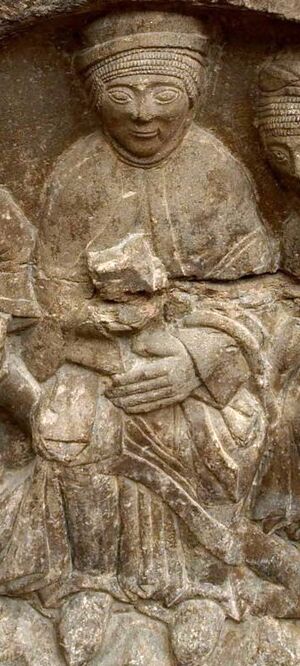Sancha of Aragon (died 1097) facts for kids
Sancha Ramírez was an important princess from the Kingdom of Aragon. She was born around 1045 and passed away in 1097. Her parents were King Ramiro I and Queen Ermesinda.
For a short time, Sancha was the countess of Urgell. This meant she was married to Count Ermengol III from about 1063 to 1065. Her brothers were Sancho Ramírez, who became King of Aragon, and García Ramírez, who became a bishop. Sancha played a big part in making the Kingdom of Aragon stronger. Her father had started this kingdom in 1035.
Sancha's Marriage
Around 1063, when Sancha was about 18 years old, she married Count Ermengol III of Urgell. He was much older than her and had been a count since 1038. Sancha was his fourth wife.
Sadly, Count Ermengol III died in 1065, after only a few years of marriage. Sancha became a widow at just 20 years old. She stayed in Urgell for a while. She even helped her stepson, Count Ermengol IV, with official tasks. On April 12, 1065, she made a special gift to honor her late husband.
Life in the Convent
After some time, Sancha returned to Aragon. She went to live at the Santa María convent in Santa Cruz de la Serós. This was the oldest nunnery in Aragon, founded in 922.
Sancha's sister, Urraca, was already a nun there. Their father had asked her to join in 1061. Another sister, Theresa, also joined later. It is thought that King Sancho, their brother, sent Theresa there because she could not find a suitable husband.
Sancha herself did not become a nun. Instead, she helped manage the convent. She received gifts of land and money from her brother, the king. These lands were like a special allowance for her from the royal family. They later became important parts of the convent's property.
On October 27, 1070, Sancha's grandmother, also named Sancha (Sancha de Aibar), gave her some important properties. These included the monastery of Santa Cecilia de Aibar, the village of Miranda, and the estate of San Pelayo de Atés. Her grandmother had received these lands from other queens and kings. After giving these gifts, the elder Sancha joined the Santa Cruz convent herself. The younger Sancha was to use these properties until her death. After that, they would go to the Santa Cruz convent. This gift showed that Sancha, even though she was young, did not plan to marry again after 1070.
Sancha continued to manage the convent's affairs. In 1078, she traded some land with the monastery of Leire. In 1079, she did a similar land exchange with San Juan de la Peña. This time, the abbess of Santa Cruz, Mindonia, was with her. Sancha also managed the abbey of San Pedro de Siresa. In 1080, she was a witness when Count Sancho Galíndez made his will.
Sancha's Influence and Role
King Sancho, Sancha's brother, trusted her very much. She helped him make decisions and confirmed important royal documents.
In 1082, there was a disagreement between her brothers. The king gave Sancha the job of managing the church area of Pamplona and its money. She managed it until a new bishop, Pedro de Roda, was chosen in 1083. In her work at both the Santa Cruz convent and the Pamplona church area, Sancha helped bring about the Gregorian reforms. These were changes to make the church stronger and more organized. Sancha was likely one of the most important helpers for Pope Gregory VII in Spain at that time.
Sancha was present on December 4, 1094, when the church of San Juan de la Peña was officially opened. Her brother Sancho's body was also buried there that day. On December 17, 1096, Sancha and her nephew, King Peter I, confirmed a gift. This gift was made by Pedro de Roda, who had just become the bishop of Huesca. He gave property to the monastery of Saint-Pons-de-Thomières after the city of Huesca was conquered. On April 5, 1097, Sancha confirmed her nephew's gift of the cathedral of Huesca to the church.
Sources
See also
 In Spanish: Sancha de Aragón para niños
In Spanish: Sancha de Aragón para niños


